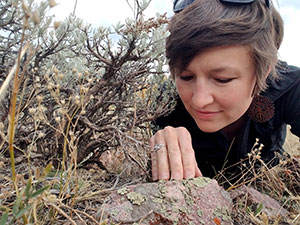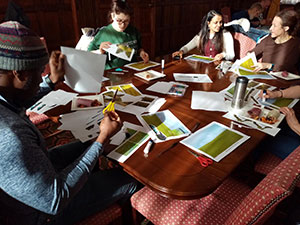UW Faculty Member Contributes to Study of What Farms in the UK Should Look Like
Published May 07, 2021

In a post-Brexit world, United Kingdom residents have a strong preference for diverse farm landscapes that include low-intensity livestock and trees, with a general dislike of wind turbines and crop monocultures.
This is according to a nationally representative survey study (2,050 participants) in which a University of Wyoming faculty member was involved. The mixed-methods approach also included a survey in which 80 U.K. residents participated in collage-creating workshops to understand aesthetic preferences for their perceived “ideal” and “environmentally friendly” farm landscapes. They each completed two collages and a short survey to explain their choices.
“The whole point of the paper was to build an understanding of what the U.K. public wants in the face of imminent, major changes in their land use/agriculture/environmental policies,” says Bethann Garramon Merkle, an assistant professor of practice in the UW Department of Zoology and Physiology, and director of research impacts assessment at UW’s Biodiversity Institute. “The U.K. used to be part of the European Union (EU), so it used to adhere to EU policies and incentive programs. Now, the U.K. government is tasked with developing a new policy framework. Now is the time to understand what the U.K. public wants prioritized in those policies.”
Merkle was a contributing author of a paper, titled “What Does the U.K. Public Want Farmland to Look Like?,” that was published April 15 in Land Use Policy. The international and interdisciplinary journal is focused on the social, economic, political, legal, physical and planning aspects of urban and rural land use.
Niki Rust, a research associate in the Centre for Rural Economy at Newcastle University in the U.K., was the paper’s lead and corresponding author. Others who contributed to the paper were from Newcastle University; the University of Cape Town in Cape Town, South Africa; and Environment and Parks, Government of Alberta in Canada.
While this particular study took place in the U.K., Merkle sees the research methods as useful closer to home.
“I see it having a lot of relevance for us in Wyoming and North America broadly, as it uses a mixed-methods approach to better understand what citizens actually want to see on the landscape,” she says. “We are deep into these kinds of discussions in Wyoming right now, so these kinds of public consultation studies can be valuable for us, too.
“This study is a powerful example of the relevance and, I would even argue, necessity of using cross-disciplinary approaches to understand public opinion,” Merkle continues. “We used both a survey and a collage process, which provided a more robust understanding than if we had used either approach alone. Given UW President Ed Seidel’s interest in interdisciplinary work, this study is a valuable example of how that can be operationalized in ways that mutually benefit research efforts and public policy.”

For example, some participants in the collage exercise ideally liked to see livestock on farms. However, to make the same farms environmentally friendly, those same participants thought it would be better to have less livestock, more trees and renewable energy options, such as wind farms. Yet, they admitted that wind farms are not aesthetically pleasing to look at.
The U.K., as part of the EU, previously adhered to EU policies and incentive programs that provided subsidies to landowners and farmers based on the amount of land they managed. Now that the U.K. has separated from the Common Agricultural Policy, the U.K. government is tasked with developing a new policy framework for agriculture and farming.
Following the data collection and analysis phases of the study, Merkle was involved with theoretical, applied and art-science integration components of the research. The paper’s results found that facilitated, arts-based methods can be useful for visualizing public expectations and preferences.
“As indicated in the paper, it’s not exactly a surprising result, but there also isn’t a lot of quantified evidence that this approach is useful in the context we studied,” Merkle says. “So, finding that out is both helpful for methods/efforts in public consultation and also a valuable contribution to our understanding of how arts-based methods can be used to enhance more quantitative research methods.”
While political decision-making on farmland in the Mountain West does not quite have the same urgency as the current situation in the U.K., our region is experiencing two intersecting influences that make the process used in the U.K. study relevant here, Merkle says. First, farmers, public lands users, policymakers and researchers are all acutely aware that local ecosystems are changing rapidly. At the same time, federal land management and community consultation policies and approaches are shifting in step with the current administration’s priorities.
“For both of these reasons, our study can provide a potential model for how researchers, agencies and communities could work to understand what their stakeholders want to see in the landscapes of Wyoming and the Mountain West,” Merkle says.

